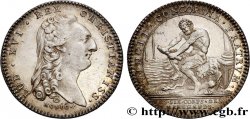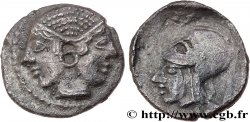Not available.
Item sold on our e-shop (2010)
Price : 65.00 €
Item sold on our e-shop (2010)
Price : 65.00 €
Type : CHASSE DE SAINT MERRY
Date: 1755
Metal : silver
Catalogue references :
Obverse
Obverse legend : LUDOV. XVI. REX. CHRISTIANISS.
Obverse description : Buste à gauche de Louis XVI non signé JP. DROZ F.[n°381].
Obverse translation : Louis XVI, toi très chrétien.
Reverse
Reverse legend : MES. CORROYEURS. PORTEURS. DE. LA. CHASSE. DE. ST. MERRY ; À L'EXERGUE : 1755.
Reverse description : Quatre bourgeois portant la châsse de St Merry, à l'exergue : instruments de corroyage.
Commentary
Les cuirs tannés forment deux grandes catégories : celle des cuirs forts et celle des cuirs à œuvre ou molleterie. Les premiers destinés à la fabrication des objets qui demandent une certaine rigidité, tels, par exemple, que les semelles des chaussures ; les seconds servant, au contraire à la confection des empeignes de souliers, des tiges de bottes et, en général, de tous les ouvrages de cordonnerie, de sellerie, de bourrellerie, etc.. qui réclament une grande souplesse. Les cuirs forts sont employés aussitôt après le tannage, tandis que les cuirs à œuvre doivent être soumis, avant d'être livrés au commerce, à des manipulations plus ou moins compliquées, ayant pour objet de les approprier aux usages spéciaux qu'on veut en faire. C'est l'exécution de ces manipulations qui constitue l'art du corroyeur.
Tanned leathers fall into two broad categories: strong leathers and working or soft leathers. The former are intended for the manufacture of objects requiring a certain rigidity, such as, for example, shoe soles; the latter are used, on the contrary, for the manufacture of shoe uppers, boot uppers and, in general, all shoemaking, saddlery, harness making, etc., which require great flexibility. Strong leathers are used immediately after tanning, while working leathers must be subjected, before being delivered to the market, to more or less complicated manipulations, the purpose of which is to adapt them to the special uses to which they are to be put. It is the execution of these manipulations which constitutes the art of the tanner
Tanned leathers fall into two broad categories: strong leathers and working or soft leathers. The former are intended for the manufacture of objects requiring a certain rigidity, such as, for example, shoe soles; the latter are used, on the contrary, for the manufacture of shoe uppers, boot uppers and, in general, all shoemaking, saddlery, harness making, etc., which require great flexibility. Strong leathers are used immediately after tanning, while working leathers must be subjected, before being delivered to the market, to more or less complicated manipulations, the purpose of which is to adapt them to the special uses to which they are to be put. It is the execution of these manipulations which constitutes the art of the tanner








 Report a mistake
Report a mistake Print the page
Print the page Share my selection
Share my selection Ask a question
Ask a question Consign / sell
Consign / sell
 Full data
Full data















